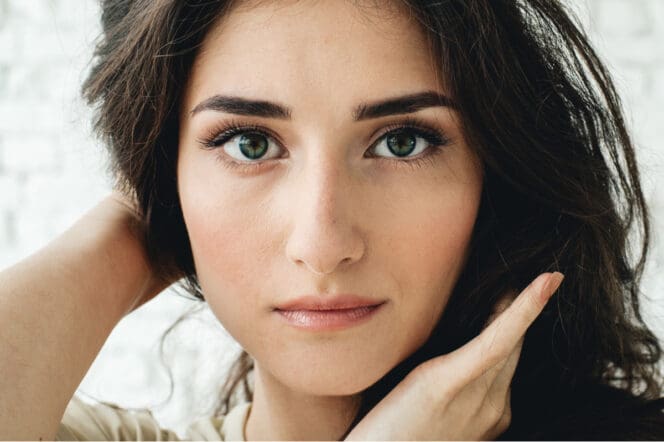People often confuse hazel with brown eyes because of the nearly similar hues. Although rare, hazel eyes have the second-highest concentration of melanin, making them appear light brown in some environments.

Typically, hazel eyes take the color of a hazelnut — a mixture of green and brown. But color combinations of other shades like gold, amber, and blue also occur.
The varying shades scatter light differently in various conditions. As a result, hazel eyes tend to swing between pure green and pure brown hues as the lighting conditions change.
Besides higher melanin concentration than other eye colors, hazel and brown eyes have no similarities.
Prevalence of Brown and Hazel Eyes
Brown is the predominant eye color in the world, present in up to 79 percent of the global population. Blue comes in a distant second with 8 percent, while only 5 out of 100 people (5 percent) have hazel eyes.
However, continental or regional eye color prevalence might follow different patterns.
For instance, 86 percent of the Irish population has blue or green eyes, while these two colors form only 12 percent of the global prevalence. In the United States, brown eyes account for about half of the population’s eye color, whereas hazel eyes occur in around 15 percent.
How Do Brown Eyes and Hazel Eyes Occur?
Different eye colors result from the varying amounts of melanin pigment within the iris, the colored part of the eye surrounding the pupil. The iris consists of two layers of muscles with several other types of cells.
Individuals with brown eyes have melanin pigments in both layers of the iris, unlike people with other eye color variants who have little melanin in the back layer.
Most people of Hispanic, Asian, and African-American descent are born with brown eyes due to high melanin levels in their skin and eyes.
On the other hand, non-Hispanic babies usually have blue eyes but the color later changes to green, hazel, or brown as they synthesize more melanin. Some people might confuse hazel with brown eyes. However, the former has slightly lower quantities of melanin.
Scientists have identified about 16 genes that influence melanin synthesis, leading to multiple eye colors. The complex interaction partially explains why parents with brown eyes can have a child with blue or green eyes.
How are Hazel Eyes Different from Brown Eyes?
Hazel eyes differ from brown eyes in many aspects, including:
| Feature | Hazel Eye | Brown Eye |
| Prevalence | Occurs in 5 percent of the world population with a higher prevalence in Europe and America | Forms 79 percent of global eye color distribution. More common in Africans, African-Americans, Hispanics and Asians |
| Pigment concentration | Melanin is present in the back layer of the iris and rarely in the front layer | Melanin-packed front and back layers of the iris |
| Nature | Appearance changes from pure green to pure brown depending on the light | Stays brown throughout life irrespective of the environment |
| Light scatter/absorption | Relatively low melanin content causes Rayleigh scattering of light leading to the hazelnut appearance. | The melanin-rich iris absorbs most of the light entering the eye. Refraction and scattering are therefore minimal. |
Facts About Brown Eyes
- Brown eyes are the most common eye color in the world
- Africans, Asians, and Hispanics are born with brown eyes, which remain brown throughout life.
- Children born with blue eyes can develop brown eyes as they grow and manufacture more melanin
- Brown eyes have a higher melanin concentration than other eye colors
- Extremely high melanin levels make some brown eyes appear dark
- Brown eyes absorb most light entering the eye with little to no refraction or scattering in the iris
Facts About Hazel Eyes
- Hazel eyes are common in Europe and America, but they only comprise 5 percent of the global eye colors.
- Hazel eyes occur in mixtures of shades, including green, brown, and gold
- The appearance of hazel eyes can change from pure green to pure brown depending on the light conditions.
- Due to the low melanin concentration, significant scattering and refraction of light occur in hazel eyes.
Myths About Brown and Hazel Eyes
It was once believed that children inherit eye color from their parents, with the brown gene being dominant and the blue recessive. Consequently, it was thought that parents with blue eyes could not have a brown or hazel-eyed child.
Current studies show that up to 16 genes are involved in eye color determination, and parents with blue or green eyes can have a child with brown eyes.
Pros and Cons for Brown and Hazel Eyes
People with brown eyes are at a lower risk of developing certain conditions like eye cancer, diabetic retinopathy, and macular degeneration. Although the relationship is still unclear, experts attribute the benefits to the protective effect of melanin.
On the flipside, brown eyes increase your risk of developing cataracts, while light-colored eyes seem protective.
References
-
The World’s Population By Eye Color. (October 2020). World Atlas.
-
Why Are Brown Eyes Most Common? (April 2017). American Academy of Ophthalmology.
-
Genotype–phenotype associations and human eye color. (October 2010). Journal of Human Genetics.
-
Iris color and cataract: the Blue Mountains Eye Study. (August 2020). American Journal of Ophthalmology.
Last Updated February 28, 2022
Note: This page should not serve as a substitute for professional medical advice from a doctor or specialist. Please review our about page for more information.